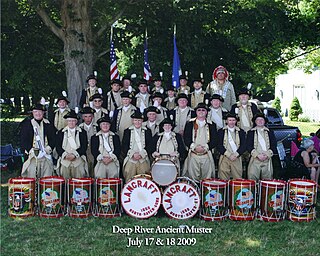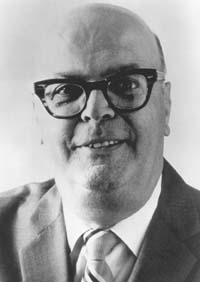Related Research Articles

The snare drum is a percussion instrument that produces a sharp staccato sound when the head is struck with a drum stick, due to the use of a series of stiff wires held under tension against the lower skin. Snare drums are often used in orchestras, concert bands, marching bands, parades, drumlines, drum corps, and more. It is one of the central pieces in a drum set, a collection of percussion instruments designed to be played by a seated drummer and used in many genres of music. Because basic rhythms are very easy to learn to play on a snare drum even for children, the instrument is also suitable for the music education for young children and a rhythm band.

A fife is a small, high-pitched, transverse aerophone, that is similar to the piccolo. The fife originated in medieval Europe and is often used in fife and drum corps, military units, and marching bands. Someone who plays the fife is called a fifer. The word fife comes from the German Pfeife, meaning pipe, which comes from the Latin word pipare.

A fife and drum corps is a musical ensemble consisting of fifes and drums. In the United States of America, fife and drum corps specializing in colonial period impressions using fifes, rope tension snare drums and rope tension bass drums are known as Ancient Fife and Drum Corps. Many of these ensembles originated from a type of military field music.

In rudimental drumming, a form of percussion music, a drum rudiment is one of a number of relatively small patterns which form the foundation for more extended and complex drumming patterns. The term "drum rudiment" is most closely associated with various forms of field drumming, where the snare drum plays a prominent role. In this context "rudiment" means not only "basic", but also fundamental. This tradition of drumming originates in military drumming and it is a central component of martial music.
Open, closed, open is a technique of playing snare drum rudiments, especially used during auditions or classical practice routines.
Sanford Augustus Moeller (1878–1960) was an American rudimental drummer, national champion, educator, and author. He was born in Albany, New York on February 16, 1878, and he began his music education by studying the piano.
George B. Bruce was an American Army drum major during the Civil War. Bruce is best known for co-writing The Drummer's and Fifer's Guide with Daniel Decatur Emmett.

The 1st Virginia Infantry Regiment was an infantry regiment raised in the Commonwealth of Virginia for service in the Confederate States Army during the American Civil War. It fought mostly with the Army of Northern Virginia.

Lancraft Fife and Drum Corps is an Ancient Fife and Drum Corps based in North Haven, Connecticut, and is a member of the Connecticut Fifers and Drummers Association. Lancraft was founded in 1888 by conservative Freemasons, but over the years has become the pride of Irish Americans.

Frank Arsenault was an internationally known American percussionist, teacher, and clinician in the areas of marching percussion, rudimental drumming, drum and bugle corps, and marching band. He was a full-time Staff Clinician and Educational Field Representative for the Ludwig Drum Company. He is also well known in his field for his signature playing style, for his many championship titles, and for his recording of The 26 Standard American Drum Rudiments and Selected Solos.
Ryan Alexander Bloom is an American drummer, author, and teacher. He is known for being a former member of the Colorado-based thrash metal band Havok, member of death metal band Bloodstrike, and the author of several books including the Double Bass Drumming Explained series and Encyclopedia Rudimentia.

The Rogue's March is a derisive piece of music, formerly used in the British, American and Canadian military for making an example of delinquent soldiers, typically when drumming them out of the regiment. It was also played during the punishment of sailors. Two different tunes are recorded; the better known has been traced back to a Cavalier taunt song originating in 1642. Unofficial lyrics were composed to fit the tune. The march was taken up by civilian bands as a kind of rough music to show contempt for unpopular individuals or causes, notably during the American Revolution. It was sometimes played out of context as a prank, or to satirise a powerful person. Historically The Rogue's March is the second piece of identified music known to have been performed in Australia.
Charles Stewart Ashworth was drum major of the United States Marine Band in the early 1800s and the author of an influential rudimental drum manual.
Fritz Berger was a Swiss drum teacher and drum method book author. He wrote several influential books on Swiss rudimental drumming, or Basler Trommeln, that are still thought of as the authoritative sources for Swiss drumming in America.
Gardiner A. Strube was an American drum major in the New York National Guard and the author of a fife and drum manual.
The National Association of Rudimental Drummers is an organization created to encourage the study of rudimental drumming. NARD is responsible for the creation of the Standard 26 American Rudiments.
Joseph Burns Moore was a champion rudimental snare drummer, member of the Connecticut National Guard, instructional author, and founding member of the National Association of Rudimental Drummers.
Alfons Grieder was a Swiss rudimental drummer who spread awareness of the Basel Drumming style in America during the mid to late 20th century through his traveling, teaching, and publications.
John Sterling "Jack" Pratt (1931–2020) was an American Army drum instructor at West Point as well as a celebrated rudimental book author. Pratt produced several volumes of rudimental solos and instructional materials and was also the founder of the International Association of Traditional Drummers (IATD), a member of the National Association of Rudimental Drummers (NARD), a member of the United States Association of Rudimental Drummers (USARD), and was inducted into the Percussive Arts Society (PAS) Hall of Fame and the World Drum Corps Hall of Fame.
Levi Lovering was an American drummer and early rudimental drum manual author. His books helped bridge the gap between colonial British military drumming and post-revolutionary American drumming.
References
- 1 2 3 "Col. H.C. Hart's New and Improved Instructor for the Drum".
- 1 2 Clark, James. Connecticut’s Fife and Drum Tradition. Wesleyan University Press, 2011.
- 1 2 Hart, H. C., Colonel. Col. H.C. Hart's new and improved instructor for the drum : with original notation. New York : William Hall & son, 1862.
- 1 2 3 "The History of the Mattatuck Drum Band". Archived from the original on 2020-01-14. Retrieved 2020-01-14.
- ↑ "News".
- 1 2 Chandler, Eric Alan, "A History of Rudimental Drumming in America From the Revolutionary War to the Present." (1990). LSU Historical Dissertations and Theses. 4901.
- ↑ "Two Drummers, Two Legacies". History of the Ancients.